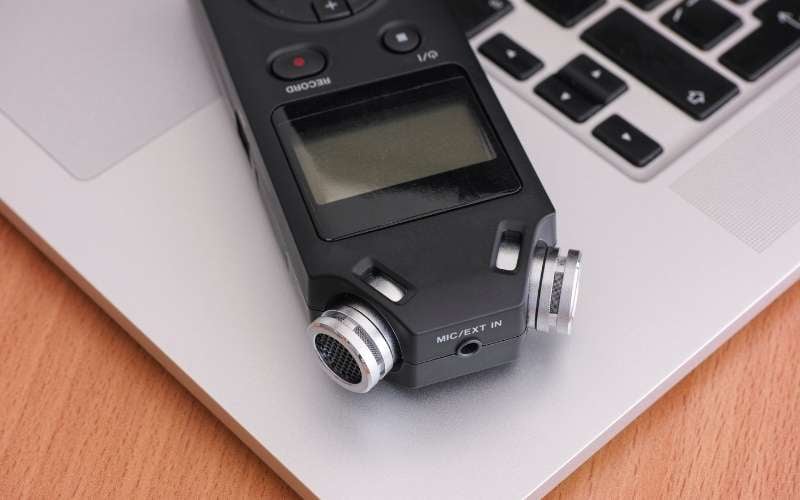If you’re looking to take control of your life by finding a rewarding career that you can work from home, then you’re far from alone.
Interest in working when and how it suits you has skyrocketed in recent times, as people seek to gain a better work/life balance.
That’s why we wrote this article on how to become a transcriptionist. There are plenty of transcription jobs out there, and this field may provide you with just what you’ve been looking for.

How to Become a Transcriptionist
Table of Contents
- How to Become a Transcriptionist
- What Does a Transcriptionist Do?
- Types of Transcription
- Skills & Equipment for Transcriptionists
- How Transcription Work Pays
- How to Become a Transcriptionist – Step by Step
- Transcription quotes
- How to Become a Transcriptionist – Final Thoughts
This guide will take you through all you should know about securing your first transcription job.
Covered is what the role involves, types of transcription work, the equipment you will need and how to find online transcription roles.
Also included is transcription training and how to carve out a niche as a freelance transcriptionist so that you can choose your own hours and clients.
It’s an ideal career for many people, from students to stay-at-home moms or retirees seeking part-time work.
Whether you want to know who hires inexperienced transcriptionists, which are the better-paying companies to work for or what an experienced transcriptionist can expect to earn, stay right here so you can learn how to work remotely, taking on a variety of transcription jobs to support your ideal lifestyle.
By the end of this piece, you will learn all about how to get your transcription career off the ground.
Within weeks, you could be offering specialised or general transcription services to companies based all over the world and being well-paid for doing just that.
Let’s get started. Firstly, let’s answer a very important question. What exactly does transcription work involve?
What Does a Transcriptionist Do?

A transcriptionist transforms an audio file into typed copy.
In other words, if you work in a transcription job, you’ll type what you hear while listening to an audio recording.
Sounds simple, right? While it’s a straightforward idea, typing at the appropriate speed is only one of the skills you’ll need to master.
Good freelance transcribers must also be able to spell, use punctuation correctly and have excellent listening skills so they don’t lose track of what’s being said.
Types of Transcription
Transcription companies tend to specialise in three main areas.
These are legal transcription, medical transcription and general transcription. Here’s more on each of those.
Legal transcription

Legal transcription is the first of two specific transcription fields. It used alongside those who work in law enforcement, such as the police force or courts.
Examples include transcribing a police interview or a recording of a witness statement that was given in court.
Medical transcription

Medical transcription is concerned with healthcare, and medical transcribers may work alongside all kinds of professionals such as doctors, nurses and physical therapists.
A typical task may be to create a letter to a patient from a brief audio recording made after a medical consultation.
General transcription
This is the broadest category in the transcription industry.
Currently there is big growth in the area of transcribing audio or video, such as YouTube footage or a podcast, into a written document to be used on a website or in print.
General transcription jobs may thus involve working with vloggers, podcasters and bloggers.
Other kinds of transcription work can also fall into this category. Unless you become a legal transcriptionist or work in medical settings, you could be working in various fields.
You may transcribe for academics, for example, creating written documents while listening to audio playback.
Anything that could be recorded on audio could later be worked on by a transcriptionist. This could, for instance, include business meetings, presentations, conferences, lectures and much more.

Skills & Equipment for Transcriptionists
So now you know what online transcription is and the types of transcription work there are.
If you’re still interested in how to become a transcriptionist, the next step is to take a look at the specialist skills and equipment required for success in this field.
Transcription skills required
If you want to become a transcriptionist, it’s a good idea to be honest with yourself from the outset.
Although the job basically involves typing up what is being said, can your typing speed keep up without having to rewind audio files all the time?
Do you have accurate typing skills, and is your grammar and spelling up to scratch?
Are you – or could you become – familiar with the likes of medical terminology (for work in medical transcription)?
How about word processing packages such as Microsoft Word, Google Docs or Apple Pages?
Are you patient enough to cope with poor quality recordings, or people who speak really quickly or with a strong regional or foreign accent?
If you fancy a work at home job in transcription, you’ll therefore need a good typing speed, spelling and grammar and the ability to work with a high level of attention to detail.
Legal transcriptionists and medical transcriptionists will additionally need to know things like legal terminology or how healthcare documentation works.
Multiple speakers of several language may also have an advantage – not least because they are used to interpreting less familiar sounds!
Transcription equipment required

Even for entry level transcription jobs you will need to have certain equipment at your disposal. Before you sign up for transcription training or take a transcription test, it’s important to consider the following requirements.
You will need the use of a reliable laptop or desktop computer, as well as a high speed internet connection.
The ability to play video or audio files on this is essential, and you will also be required to use some sort of word processing software.
It’s likely that a paid or free version of Apple Pages or Microsoft Word is already installed on your computer, but do you know how to use it?
Google Docs is a good alternative, and everything you type is saved, more-or-less immediately, to the cloud. It’s also free and simple to use.
Some transcription companies may insist upon you using Word, however, or their own transcription software.
Where this is required for a transcription job, it will normally be quick and simple to install.
You may even need to use a specific browser on your PC or laptop – such as Google Chrome – to access the company’s own transcription software.
Suitable headphones will be required to ensure you can hear audio files being played back as clearly as possible.
These help to block out other sources of sound as well as directing the sounds right into your ear, meaning you can concentrate fully on what’s being said while undertaking online transcription tasks.
Some transcription companies – especially those at the higher-paying end of the market – may also require you to use a foot pedal or to have your own transcription software. There’s more on these later in this guide.
How Transcription Work Pays

In most trades or professions, the way people are paid is calculated according to what they produce and/or the time spent.
For example, a tradesperson may be paid per hour or per day. A temporary office worker will normally be paid per hour. And so on.
Some will also give a quote for a specific job. A carpenter may state a set price for installing fitted closets into a bedroom, for instance, while a bookkeeper might charge a flat rate for completing a tax return.
The way transcription work is paid
Transcription work is rather different. Transcription jobs pay per audio hour or even per audio minute.
This can be deceptive, as an audio minute is not the same as sixty seconds, or a minute as measured by the clock.
An audio hour is thus not comparable to an hour in real time, yet this is how transcription companies will pay you.
The key here is to know this: an audio minute or hour will take longer to transcribe than sixty seconds or sixty minutes, respectively.
So it follows that what you need to know is this. How long does it take you to transcribe one audio hour?
Once you know how quickly you can transcribe video or audio files into written documents, you can determine how much transcription gigs will pay.
How much transcription work pays

So, how much can you expect to earn by taking on these video or audio projects and transforming recordings into written text?
As with many online jobs, most companies will pay beginners less. The question of how much copy you personally can create from one audio hour also comes into play.
It stands to reason that complete beginners will make far less than experienced transcriptionists.
First, you could be paid anything from just a few dollars per hour to a little more.
As you progress, however, you could soon be making double or even more.
Once you become an established freelance transcriptionist with many regular clients, saying goodbye to those lower-paying companies makes sense.
This scenario applies to many freelance careers, not only transcription. A rookie writer, for example, may hone their craft by working for what are sometimes known as ‘content mills’.
These typically pay per word, and as an inexperienced writer isn’t anywhere near as quick as one who has done the job for years, earnings may be small at the outset.
There are two ways to look at this. On one hand, you could say why work for less than minimum wage.
Or you could take a longer-term view. It costs far more to learn any profession via the college or university route, where you may pay for your tuition fees and living costs or earn no money at all.
Taking on online transcription tasks allows you to hone your craft at your own pace, with a view to working towards higher paid freelance transcription jobs at a later date.
This can be a great alternative to formal training. If you already have the computer, internet connection and software it will cost you next to nothing, and what you earn will increase steadily as you gain experience.
Doing this will also give you the experience to work out what you can really earn per audio hour – and, thus what you will be paid in cold, hard cash for each gig.
How to Become a Transcriptionist – Step by Step
So, let’s assume you’re still interested and think your skills may be a good fit.
You can type and already have a decent computer with word processing software and high-speed internet. What comes next?
1. Test your typing speed, accuracy and grammar

Before you start trying to find transcription jobs, you need to know how quickly and accurately you can type. Speed isn’t quite so important here, as this will improve with experience.
Remember that you’re paid in audio minutes or hours, not real-time ones, so it doesn’t matter to transcription companies how long you take to complete a piece of work.
Accuracy is far more important. What takes more time is correcting mistakes and researching unfamiliar terms, as well as trying to decipher speech that is difficult to understand.
You can’t do much about the latter, but a high level of accuracy will make you seem far more professional.
If you are more accurate, it logically follows that you’ll also be faster as you’re not going back to correct lots of spelling mistakes, grammatical errors or typos.
You can check your typing speed and accuracy online in as little as a minute via sites like typingtest.com.
Or simply Google ‘free online typing test’ and go for one you like the look of.
Typically, higher-level transcription companies will require around 65 words per minute or more, so that’s a good point of reference to aim for.
In terms of accuracy, the closer you can get to 100% the better.
If you’d also like to test your vocabulary and use of grammar, you can take a brief online English test here.
2. Try out transcription
There are several transcription companies offering the chance to try out transcription for yourself. These can be accessed via their websites.
Here at Mum’s Money we think it’s well worth taking the time to do these, as how else can find out whether transcription really is the right job for you?
Go Transcript is the ideal first port of call, because you don’t need to download any software. Simply click a link (on the left) to see how you get on.
You may be pleasantly surprised… and if not remember you can only improve with practice! The only way is up.
If you don’t mind investing a few dollars into making sure transcription is for you – while giving you a head start into paid work in this area – you could also consider taking a course.
3. Take a transcription course

If you want to know more, taking a short online course will open your eyes to the whole new world of transcription.
There is lots of choice on sites such as Udemy and SkillShare. At the time of writing, a quick search on Udemy turned up over 200 courses.
Options range from general courses for all levels to more specialist ones aimed at those who want to offer legal or medical transcription services.
If you want to take a short, low cost course, here are some of those the Mum’s Money team recommends:
Transcription practice A, B & C – Amanda Fichter
These 3 courses are designed to act as a transcription simulator, giving you real, hands-on experience. Levels A, B and C each comprise 25 audio files for you to practice transcribing.
The series is devised by Amanda Fichter, a transcriptionist with 17 years’ experience. See course A here.
Step-by-step transcription – Amanda Fichter
From the same course leader comes this two hour course.
Consisting of 14 lectures, it gives you all the tools you need to begin a rewarding career in transcription, choosing your own hours and working from home. Check out step-by-step transcription here.
Becoming a transcriptionist – Chelsea Flint
This general course is just as highly rated, and includes 26 lectures. It’s aimed at beginners, so you can be confident that it’s easy to follow.
The course teaches all you must know to work as a contractor for transcription companies. Find out how to become a transcriptionist here.
Become a medical transcriptionist – Cody Lee
Including real life files from doctor’s surgeries and other medical settings, this course will give you a good basic grounding.
If you want to know what’s involved in creating healthcare documentation, this could be the course for you. Find out more about becoming a medical transcriptionist here.
Learn transcription from scratch – Shelmith Mwangi
This course promises to help those with a typing speed of 35 words per minute – assuming you already have good command of grammar, a computer, internet connection and headphones.
The course includes 13 downloadable resources and lifetime access. There’s more about learning transcription from scratch here.
4. Choose a transcription company

When you’re ready to start looking for work as a transcriptionist, it’s worth bearing this factor in mind when deciding which company to go with: each has their own set of transcription guidelines.
Transcription company guidelines
You’re likely to have to take a transcription test when signing up, and to ensure you have the best chance of success with this you should familiarise yourself with the specific company guidelines.
This covers issues like what to do if you cannot make out what someone is saying, how to refer to each individual speaker and how to type up a mispronounced word.
For example, take a look at Go Transcript’s guidelines here.
Transcription companies who hire beginners
If you’re prepared to work for relatively low pay at first while you learn all about the art of transcribing, there are a number of companies willing to hire those just starting out.
Yes, they get the work done for a cheap rate, but you gain the most valuable commodity of all in the process. Experience.
Take a look at all or some of the following when you’re ready to take that first step into a new career.
- Go Transcript
- Speechpad
- Way With Words
- GMR Transcription
- Quicktate
- Transcribe Me
- Rev
- Daily Transcription
- Tigerfish
- 3 Play Media
- Scribie
- Crowd Surf
- Transcription Wing
Some require Spanish as well as English speakers, while others may be best for medical or legal work.
5. Progress your transcription career
Once you’ve nabbed your first paid transcription gig, much of the rest will follow with experience.
When you’ve built up a good level of speed and accuracy, it may be time to spread your wings a little. So what’s next?
Invest in transcription equipment

As with most things, having the right kit can make life so much easier. In this case, it can make you a more efficient transcriptionist too.
Assuming you have headphones, a computer and fast internet, the next item you could invest in is a foot pedal.
What for? A foot pedal allows you to use your foot to play, pause, rewind or fast-forward audio files.
This frees your fingers to fly quickly and accurately across the keyboard, increasing your overall speed.
Check out a highly rated, well priced foot pedal here.
Another useful weapon to add to your armory is software such as Trint, which is compatible with both Apple and Windows devices.
This can speed up work time, and can be used with video or audio files. Check it out here.
Sign up with transcription companies who pay more
Making the move to a transcription company that pays more is really a no-brainer once you’ve built up some experience. Here are some to check out.
Use freelance sites and networking

If you want the best-paying transcription gigs, then it’s best to find your own clients. You can do this by using freelancer sites like Upwork, Freelancer, Fiverr and People Per Hour.
Networking can also work wonders. Look around on Facebook for blogger, vlogger and podcaster groups and join them, as people you connect with there may well be looking for a reliable transcriptionist.
Don’t forget LinkedIn too – many freelancers find a lot of work because they spend time networking on this business-oriented version of social media.
Take an intermediate or specialist course.
With cheap courses available via sites like Udemy, you don’t have to spend a lot to learn from the experts in their field.
The beginner to advanced transcription skills course is a great example, and also created by Chelsea Flint (who wrote the ‘becoming a transcriptionist’ course featured earlier).
Find out more about transcription skills: beginner to advanced here.
If you’re interested in further training, take a look at Transcribe Anywhere, whose courses aim to help you build a successful business. There are courses in legal and general transcription. You can also enrol on a free, 7-lesson mini course to get a taste of what is offered.
Many community colleges and vocational schools offer certification programs for those aiming to become a medical or legal transcriptionist.
These can last from one year to three depending on how much time needs invested in order to receive these qualifications.
The Association for Healthcare Documentation Integrity offers two certification programs to help you work in healthcare documentation.
Those who are aspiring to be a medical transcriptionist can get certified as either Registered Healthcare Documentation Specialist (RHDS) or Certified Healthcare Documentation Specialist (CHDS).
Court reporters are courtroom professionals who use an old-fashioned technique to transcribe the dialogue.
They must be appropriately trained and certified, like other professions that require special skills such as doctors or lawyers because their work can have life threatening consequences if done incorrectly!
The NCRA (National Court Reporters Association) offers various certification courses as does the NVRA (National Verbatim Reporters Association).
Transcription quotes
“You know you are a transcriber when you visualise the typing in your mind when you are listening to conversations.” – Teresa W, GMR Transcription.
“It really doesn’t matter where the transcription is provided, the technology is the same. It’s the idea of getting the work completed that matters to the bottom line.” – Chris Hopkins
“Breathe new life into your recorded content by transcribing it, slicing it up, and turning it into something fresh.” – Rev.
How to Become a Transcriptionist – Final Thoughts
As we at the Mum’s Money team know, being your own boss has many advantages.
Reasons why you should become a transcriptionist include the fact that you’re in control of the work you do as well as your hours and your finances.
When you work freelance, you can work as, when and where it suits you and your family. If you’re self-motivated and can manage your time effectively, freelance work could suit you perfectly.
Working as a legal, medical or general transcriptionist could also be for you if you can type quickly and accurately and have good grammar.
This work also frees you up to see your friends and spend time with your family whenever you want, with no boss breathing down your neck.
In addition, the nature of the work means you’re likely to learn something new daily, and your earning power will increase as you progress.
You can also save so much time and money by avoiding the commute and no longer having to buy train tickets, coffees and lunches or even work clothes.
If this article has piqued your interest, why not take the first step towards your new career today?
Related:
